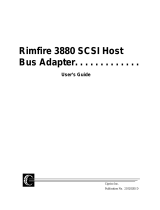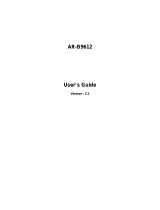
Introduction
http://www.mcg.mot.com/literature 1-3
1
Models Available
As of the publication date of this manual, the MVME162LX Embedded
Controller is available in a number of models shown in Table 1-1.
Table 1-1. MVME162LX Embedded Controller Models
Model Description
-200 MC68LC040 25 MHz microprocessor, 1 MB DRAM,
128 KB SRAM,1 MB Flash memory, 2 IndustryPack sites
-201 MC68LC040 25 MHz microprocessor, 1 MB DRAM,
128 KB SRAM,1 MB Flash memory, 2 IndustryPack sites, 4 serial ports
-202 MC68LC040 25 MHz microprocessor, 1 MB DRAM,
128 KB SRAM,1 MB Flash memory, 2 IndustryPack sites, 4 serial ports
-210 MC68LC040 25 MHz microprocessor, 4 MB DRAM, 128 KB SRAM,
1 MB Flash memory, 2 IndustryPack sites, 4 serial ports
-211 MC68LC040 25 MHz microprocessor, 4 MB DRAM, 128 KB SRAM,
1 MB Flash memory, 2 IndustryPack sites, 4 serial ports, SCSI
-212 MC68LC040 25 MHz microprocessor, 4 MB DRAM, 128 KB SRAM,
1 MB Flash memory, 2 IndustryPack sites, 4 serial ports, Ethernet
-213 MC68LC040 25 MHz microprocessor, 4 MB DRAM, 128 KB SRAM,
1 MB Flash memory, 2 IndustryPack sites, 4 serial ports, SCSI &
Ethernet
-216 MC68LC040 25 MHz microprocessor, 4 MB DRAM, 128 KB SRAM,
1 MB Flash memory, 2 IndustryPack sites, Ethernet, No VME
-220 MC68040 25 MHz microprocessor, 4 MB DRAM, 128 KB SRAM,
1 MB Flash memory, 2 IndustryPack sites, 4 serial ports
-222 MC68040 25 MHz microprocessor, 4 MB DRAM, 128 KB SRAM,
1 MB Flash memory, 2 IndustryPack sites, 4 serial ports, Ethernet
-223 MC68040 25 MHz microprocessor, 4 MB DRAM, 128 KB SRAM,
1 MB Flash memory, 2 IndustryPack sites, 4 serial ports, SCSI &
Ethernet
-233 MC68LC040 25 MHz microprocessor, 4 MB ECC DRAM,
128 KB SRAM, 1 MB Flash memory, 2 IndustryPack sites, 4 serial ports,
SCSI & Ethernet





















